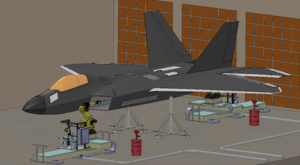F-22 | How It’s Painted
The manual process for painting an F-22 is time consuming, physically taxing, and full of potential hazards. Painters are required to wear heavy and constricting personal protective equipment while manipulating a paint gun and maneuvering in cramped spaces, such as inlet ducts. Contorting to the perfect position just to accurately paint one small section after another in repeatable thickness over the course of several days is far from ideal—for painters and the process as a whole. The industry realized something in this process had to change; that’s when Aerobotix came in to help.

Aerobotix worked with Lockheed Martin, AFRL, and Hill AFB to modify FANUC robots able to streamline and improve the process of coating F-22 inlets on full body aircraft. Redevelopment of the process began with data collection and special consideration of the complex shape of F-22 inlets. Due to the complex shape, robots had to be modified with carbon fiber tubes and a smaller footprint overall. Carbon fiber tubes are both light and sturdy enough for automated robot manipulation and avoid warping from repeated use over time.
Overlap from painting the front and aft of the duct was also taken into consideration, resulting in carefully programmed robotic paths to create an even coating. Additionally, air bearings were integrated in the rails to allow one robot to paint both the left and right sides of the front of the aircraft and another to paint both sides of the aft. These considerations are just examples of the numerous items that Aerobotix accounts for in each robotic system.
For more information and to start designing your own unique robotic system, contact Aerobotix at info@aerobotix.net.
Robots Are the F-22 Raptor's Secret Weapon – 19FortyFive – Golden AI
[…] stealthy – specially-designed robots that were developed to help maintain the aircraft. Aerobotix worked directly with Lockheed Martin, the Air Force Research Laboratory (AFRL), and Hill Air Force Base (AFB) to […]
Robots Are the F-22 Raptor's Secret Weapon - News National
[…] Aerobotix worked directly with Lockheed Martin, the Air Force Research Laboratory (AFRL), and Hill Air Force Base (AFB) to modify FANUC robots able to streamline and improve the process of coating F-22 inlets on full-body aircraft. […]